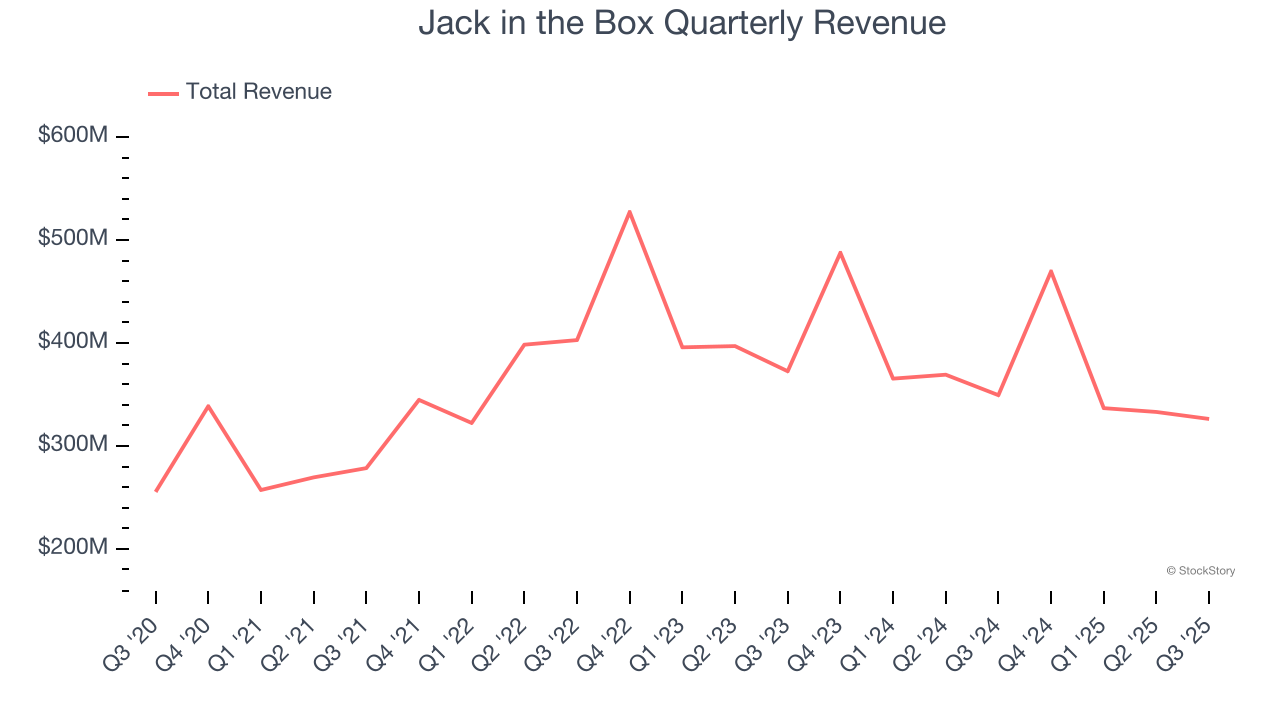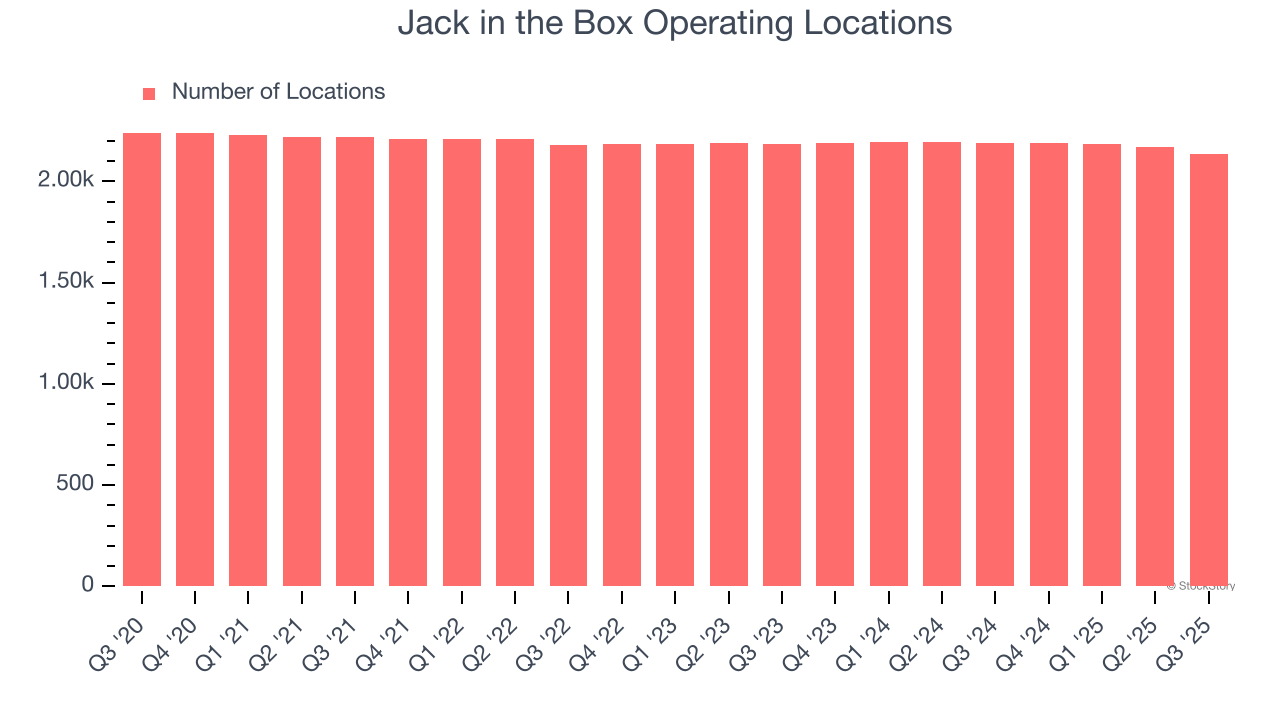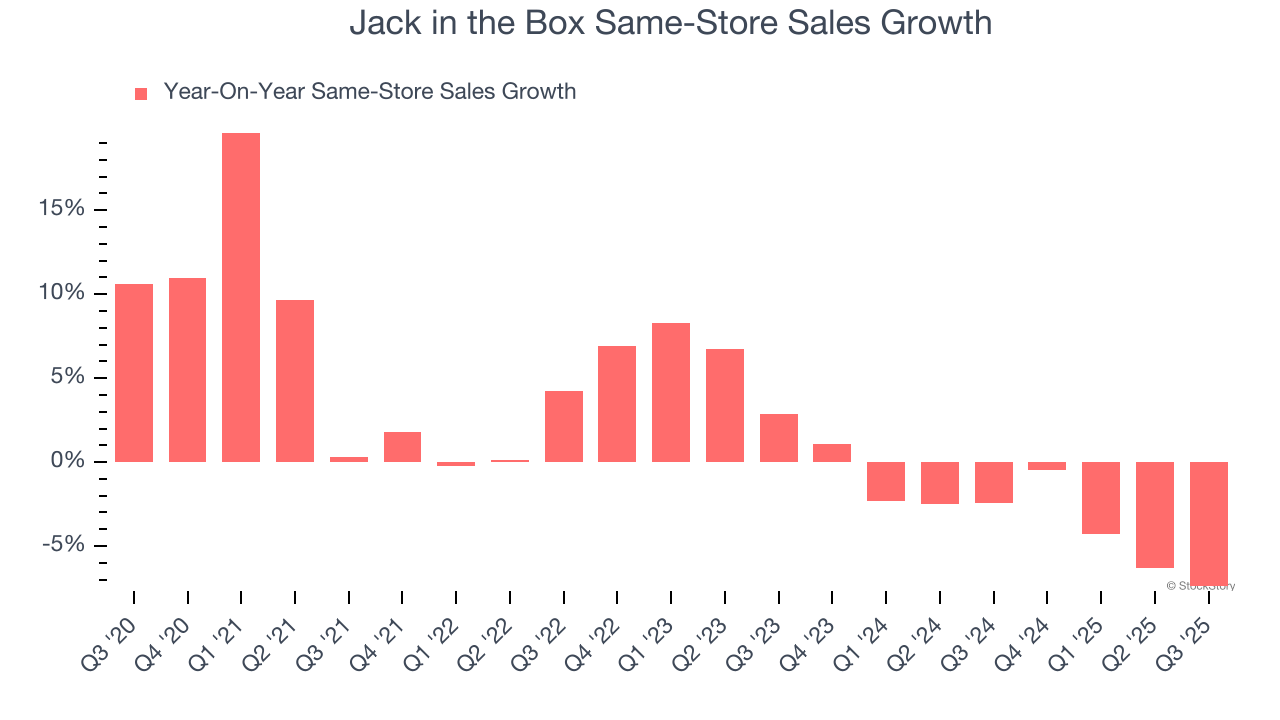
Fast-food chain Jack in the Box (NASDAQ: JACK) reported Q3 CY2025 results beating Wall Street’s revenue expectations, but sales fell by 6.6% year on year to $326.2 million. Its non-GAAP profit of $0.30 per share was 37.4% below analysts’ consensus estimates.
Is now the time to buy Jack in the Box? Find out by accessing our full research report, it’s free for active Edge members.
Jack in the Box (JACK) Q3 CY2025 Highlights:
- Revenue: $326.2 million vs analyst estimates of $318.3 million (6.6% year-on-year decline, 2.5% beat)
- Adjusted EPS: $0.30 vs analyst expectations of $0.48 (37.4% miss)
- Adjusted EBITDA: $45.6 million vs analyst estimates of $47.23 million (14% margin, 3.5% miss)
- EBITDA guidance for the upcoming financial year 2026 is $232.5 million at the midpoint, below analyst estimates of $265.2 million
- Operating Margin: 7.4%, down from 14.6% in the same quarter last year
- Locations: 2,136 at quarter end, down from 2,191 in the same quarter last year
- Same-Store Sales fell 7.4% year on year (-2.4% in the same quarter last year)
- Market Capitalization: $269.1 million
Company Overview
Delighting customers since its inception in 1951, Jack in the Box (NASDAQ: JACK) is a distinctive fast-food chain known for its bold flavors, innovative menu items, and quirky marketing.
Revenue Growth
Reviewing a company’s long-term sales performance reveals insights into its quality. Any business can put up a good quarter or two, but the best consistently grow over the long haul.
With $1.47 billion in revenue over the past 12 months, Jack in the Box is a mid-sized restaurant chain, which sometimes brings disadvantages compared to larger competitors benefiting from better brand awareness and economies of scale. On the bright side, it can still flex high growth rates because it’s working from a smaller revenue base.
As you can see below, Jack in the Box’s 7.5% annualized revenue growth over the last six years (we compare to 2019 to normalize for COVID-19 impacts) was decent despite not opening many new restaurants.

This quarter, Jack in the Box’s revenue fell by 6.6% year on year to $326.2 million but beat Wall Street’s estimates by 2.5%.
Looking ahead, sell-side analysts expect revenue to decline by 5.7% over the next 12 months, a deceleration versus the last six years. This projection is underwhelming and suggests its menu offerings will see some demand headwinds.
Software is eating the world and there is virtually no industry left that has been untouched by it. That drives increasing demand for tools helping software developers do their jobs, whether it be monitoring critical cloud infrastructure, integrating audio and video functionality, or ensuring smooth content streaming. Click here to access a free report on our 3 favorite stocks to play this generational megatrend.
Restaurant Performance
Number of Restaurants
A restaurant chain’s total number of dining locations influences how much it can sell and how quickly revenue can grow.
Jack in the Box listed 2,136 locations in the latest quarter and has kept its restaurant count flat over the last two years while other restaurant businesses have opted for growth.
When a chain doesn’t open many new restaurants, it usually means there’s stable demand for its meals and it’s focused on improving operational efficiency to increase profitability.

Same-Store Sales
A company's restaurant base only paints one part of the picture. When demand is high, it makes sense to open more. But when demand is low, it’s prudent to close some locations and use the money in other ways. Same-store sales is an industry measure of whether revenue is growing at those existing restaurants and is driven by customer visits (often called traffic) and the average spending per customer (ticket).
Jack in the Box’s demand has been shrinking over the last two years as its same-store sales have averaged 3.1% annual declines. This performance isn’t ideal, and we’d be concerned if Jack in the Box starts opening new restaurants to artificially boost revenue growth.

In the latest quarter, Jack in the Box’s same-store sales fell by 7.4% year on year. This decrease represents a further deceleration from its historical levels. We hope the business can get back on track.
Key Takeaways from Jack in the Box’s Q3 Results
We enjoyed seeing Jack in the Box beat analysts’ revenue expectations this quarter. On the other hand, its full-year EBITDA guidance missed and its EPS fell short of Wall Street’s estimates. Overall, this was a weaker quarter. The stock traded down 5.2% to $13.62 immediately following the results.
Jack in the Box’s latest earnings report disappointed. One quarter doesn’t define a company’s quality, so let’s explore whether the stock is a buy at the current price. When making that decision, it’s important to consider its valuation, business qualities, as well as what has happened in the latest quarter. We cover that in our actionable full research report which you can read here, it’s free for active Edge members.






